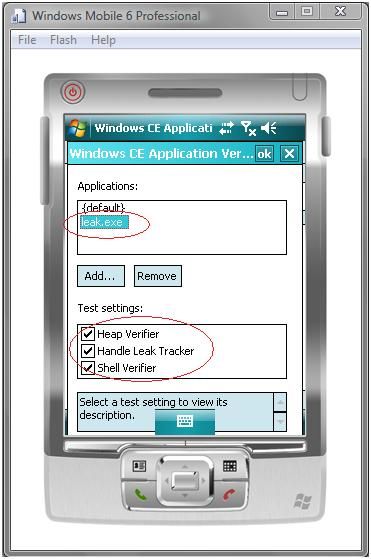最近在论坛里看到很多人问怎样检查内存泄漏,对于Windows CE/Windows Mobile开发,微软已经为我们提供了很好的工具Application Verifier。AppVerifier是一个辅助开发工具,不用修改代码,可以检测出程序内存,句柄, GDI对象泄漏,并报告分配泄漏对象的调用栈,有过在大规模代码里查资源泄漏的兄弟应该知道这个调用栈的价值。
在中文google里搜了下,没有发现讲这个工具使用的文章,我就写个简单的使用说明,让大家知道并利用好这个工具吧。在MSDN里有很多关于AppVerifier的资料,有兴趣可以直接去http://msdn.microsoft.com搜。后面我附上几个不错的链接。注意:
1. AppVerifier的原理是hook分配和释放资源的API,在程序调用这些API时记录信息,在程序退出时报告出未释放的资源。
2. 只能检测Native代码。
3. 程序正常退出才行,强行杀进程不能得到正确的报告。
4. 基于原理,只能做Run-time检测。尽量使用程序的所有功能已保证检测到更多代码。
测试代码
void LeakMemory()
{
BYTE* p = new BYTE[10];
NKDbgPrintfW(L"Allocated memory: 0x%X", p);
}
void LeakHandle()
{
HANDLE h = CreateEvent(NULL, FALSE, FALSE, L"leaked_event");
NKDbgPrintfW(L"Created event: 0x%X", h);
}
int WINAPI WinMain(HINSTANCE hInstance, HINSTANCE hPrevInstance, LPTSTR lpCmdLine, int nCmdShow)
{
LeakMemory();
LeakHandle();
return 0;
}
很简单,泄漏一点内存和一个Event句柄。编译该代码生成Leak.exe/Leak.pdb/Leak.map,AppVerifier使用MAP文件查找调用栈的函数符号。下面我会分别说在Windows CE和Windows Mobile下的使用。
Windows CE
我是基于Windows CE 6测试的。PB6已经集成到Vistual Studio里了。
1. PB自带了AppVerifier, 拷贝D:\Program Files\Microsoft Platform Builder\6.00\cepb\wcetk\ddtk\armv4i目录下的下面这些与AppVerifier相关的文件到Release或者设备的\Windows目录。
appverif.exe
htracker.dll
shimexp.exe
shim_heap.dll
shim_hleak.dll
shim_usergdi.dll
shim_verifier.dll
shimeng.dll
vlog.dll
symhlp.dll
在D:\Program Files\Microsoft Platform Builder\6.00\cepb\wcetk\ddtk目录下有desktop/x86/armv4i等子目录。Desktop目录下的文件是运行在desktop版Windows里(2000/XP/Vista)的,需要通过ActiveSync或者KITL等连接到Device上。别的目录是运行在相应平台的Device上的。后面Windows Mobile里AppVerifier的目录结构一样。
上面的appverif.exe是AppVerifier在Device上运行的程序,带UI,也支持命令行参数,在PB的Target Control里输入s appverif –h即可看到帮助。
Ø 为了简单,我拷贝了这个目录下所有文件到Release目录:
在PB里打开Build Window,然后
D:\WINCE600>copy "D:\Program Files\Microsoft Platform Builder\6.00\cepb\wcetk\ddtk\armv4i\*" %_FLATRELEASEDIR%
Ø 也可以使用Remote File Viewer把这些AppVerifier相关的文件拷贝的\Windows目录。
2. 拷贝待测试程序和MAP文件到Release或者Device的Windows目录,也就是Leak.exe/Leak.map。
3. 运行D:\Program Files\Microsoft Platform Builder\6.00\cepb\wcetk\ddtk\desktop\AppVerifCE.exe (PB的安装目录下)
![]()
4. 选择Add…,输入待检测的exe文件名Leak.exe,不用全路径,并选中右边Test settings里要测试的项目,一般全选
![]()
5. 选择Connect…
![]()
6. 选择Connect…
![]()
这里选要连接的Device,我这里选Default Device,属性如下,运行在Device Emulator里带KITL的image。
![]()
7. 连接成功以后运行Leak.exe,在PB的Target Control里输入s Leak.exe。可以看到Output窗口里有如下输出:
1532862 PID:206001e TID:207001e Allocated memory: 0x2C022DD0 //这两行是程序输出的
1532878 PID:206001e TID:207001e Created event: 0x521603
1532985 PID:206001e TID:207001e Application verifier core unloaded from: leak.exe - 11:39:44 PM
1533001 PID:206001e TID:207001e DLL_PROCESS_DETACH: Shim_heap checking for abandoned heaps/allocations...
1533094 PID:206001e TID:207001e Heap statistics for heap 0x2c020010:
1533108 PID:206001e TID:207001e Initial size: 0, Maximum size: 0
1533122 PID:206001e TID:207001e Current bytes: 10, Max: 10
1533136 PID:206001e TID:207001e Current count: 1, Max: 1
1533150 PID:206001e TID:207001e Free list bytes: 0
1533164 PID:206001e TID:207001e Free list size: 0
1533183 PID:206001e TID:207001e Checking for un-freed items in heap 0x2c020010...
1533244 PID:206001e TID:207001e ----------------------------------------
1533260 PID:206001e TID:207001e TrackedItem count: 1
1533273 PID:206001e TID:207001e Callstack:
1533368 PID:206001e TID:207001e Console NOT redirected for process 0x206001E
1533506 PID:400002 TID:207001e RELFSD: Opening file shim_heap.map from desktop
1535138 PID:206001e TID:207001e 0x41e98310: shim_heap.dll!APIHook_HeapAlloc + 5d0h
1535220 PID:206001e TID:207001e 0x41e9b378: shim_heap.dll!APIHook_LocalAlloc + a8h
1535303 PID:206001e TID:207001e 0x41e9c2f4: shim_heap.dll!APIHook_malloc + 18h
1535392 PID:206001e TID:207001e 0x41e9c54c: shim_heap.dll!APIHook_new + 14h
1535596 PID:400002 TID:207001e RELFSD: Opening file leak.map from desktop
1535746 PID:206001e TID:207001e 0x000110e0: leak.exe!?LeakMemory@@YAXXZ + ch //这是内存泄漏的调用栈
1535892 PID:206001e TID:207001e 0x0001116c: leak.exe!WinMain + 10h
1536088 PID:206001e TID:207001e 0x00011208: leak.exe!WinMainCRTStartupHelper + 28h
1536210 PID:206001e TID:207001e 0x000111cc: leak.exe!WinMainCRTStartup + 20h
1536341 PID:400002 TID:207001e RELFSD: Opening file coredll.map from desktop
1546679 PID:206001e TID:207001e 0x40071f5c: coredll.dll!MainThreadBaseFunc + 2a0h
1546768 PID:206001e TID:207001e Un-freed items:
1546854 PID:206001e TID:207001e 0x2c022dd0 10 bytes, process: 0x0206001e, thread://泄漏的内存地址和大小,可以看出和程序里的一致
0x0207001e, PerfCount: 1021127120
1546941 PID:206001e TID:207001e Total: 10 bytes
1547026 PID:206001e TID:207001e Checking for leaks in marshall helper api's...
1547043 PID:206001e TID:207001e ------------------------------------------------------------------------
1547045 PID:206001e TID:207001e Shim HLeak detaching from process \Release\leak.exe
1547046 PID:206001e TID:207001e Num of un-freed handles = 1
1547046 PID:206001e TID:207001e Check log file for details
1547046 PID:206001e TID:207001e ------------------------------------------------------------------------
1547047 PID:206001e TID:207001e ----------------------
1547256 PID:206001e TID:207001e EVENT Handle = 0x00521603 Name: 'leaked_event' PerfCount: 1021895588 //泄漏的句柄,可以看出何程序里是一样的
1547338 PID:206001e TID:207001e Callstack:
1547430 PID:400002 TID:207001e RELFSD: Opening file shim_hleak.map from desktop
1548302 PID:206001e TID:207001e 0x41e84814: shim_hleak.dll!My_TrackerInsertItem2 + e0h
1548409 PID:206001e TID:207001e 0x41e84710: shim_hleak.dll!My_TrackerInsertItem + 24h
1548486 PID:206001e TID:207001e 0x41e84c00: shim_hleak.dll!APIHook_CreateEventW + 68h
1548653 PID:206001e TID:207001e 0x0001112c: leak.exe!?LeakHandle@@YAXXZ + 18h //泄漏句柄的调用栈
1548819 PID:206001e TID:207001e 0x00011170: leak.exe!WinMain + 14h
1548979 PID:206001e TID:207001e 0x00011208: leak.exe!WinMainCRTStartupHelper + 28h
1549136 PID:206001e TID:207001e 0x000111cc: leak.exe!WinMainCRTStartup + 20h
1549219 PID:206001e TID:207001e 0x40071f5c: coredll.dll!MainThreadBaseFunc + 2a0h
1549240 PID:206001e TID:207001e DLL_PROCESS_DETACH: Shim_usergdi checking for abandoned resources...
1549340 PID:206001e TID:207001e --------------------------------------------------------------------------------
1549355 PID:206001e TID:207001e VLOG exiting - check for verifier logs (22 info, 5 warnings, 0 errors)
1549368 PID:206001e TID:207001e Process log: \release\AppVerifier_leak_2339.log //这是日志文件,文本格式,可以直接打开看
1549381 PID:206001e TID:207001e --------------------------------------------------------------------------------
对于日志文件,也可以在图1的界面里选择Get Logs…保存日志到本地,然后选择View Exported Log…看,如本测试的日志文件
Windows Mobile
1. 去下面地址下载安装。虽然写的是for Windows Mobile 5,但也适用于Windows Mobile 6。
http://www.microsoft.com/downloads/details.aspx?FamilyID=d275348a-d937-4d88-ae25-28702c78748d&DisplayLang=en
注意Instructions节里的:
For systems that have never installed Platform Builder, complete the following additional steps:
1. Install the Windows CE 5.0 Stand Alone CETK (this provides connection libraries needed).
2. Replace the Application verifier binaries in the processor folder for the device type. For example, replace C:\Program Files\Windows CE platform builder\5.00\CEPB\wcetk\DDTK\ARMV4I with C:\Program Files\Application Verifier for Mobile 5.0\Armv4i.
当你需要在Desktop上运行AppVerifier然后连接Device(像我在演示Windows CE里做的)时需要做这两步。我下面将演示直接在Device上运行,所以不用这两步。
2. 启动Mobile设备,我这里用的Device Emulator
3. 拷贝D:\Program Files\Application Verifier for Mobile 5.0\Armv4i目录下的与AppVerifier相关的文件到Device Emulator里的Windows目录。
4. 拷贝待测试程序和MAP文件到Device,也就是Leak.exe/Leak.map,其中Leak.map得拷贝到\Windows目录,不然生成的日志里看不到函数符号。生成MAP文件需要修改工程属性如下,改Generate Map File为Yes。
![]()
5. 在Device Emulator里运行\Windows\AppVerif.exe,选择Add…添加Leak.exe并选择Test settings。
6. 在Device上运行Leak.exe,会在Device的根目录生成日志文件,比如\ AppVerifier_Leak_1643.log。直接用记事本打开就可以看到日志,或者运行D:\Program Files\Application Verifier for Mobile 5.0\Desktop\ AppVerifCE.exe,然后选择View Exported Log…看。
7. 发现有时候打开log,里面的符号不能被正确解析。解决方法:
1) 打开log文件, 把类似下面callstack里不正确解析的符号
| shim_heap.dll 30 | 0 nk.exe 8803754c' 0x1c04eac4: !(null) + 4eac4h
| shim_heap.dll 30 | 0 nk.exe 8803754c' 0x1c04b2f0: !(null) + 4b2f0h
| shim_heap.dll 30 | 0 nk.exe 8803754c' 0x1c04bad4: !(null) + 4bad4h
| shim_heap.dll 30 | 0 nk.exe 8803754c' 0x1c0530f0: !(null) + 530f0h
都改为:
| shim_heap.dll 30 | 0 nk.exe 8803754c' 0x1c04eac4: leak.exe!(null) + 4eac4h
然后像第6步里一样打开log,会提示map文件的位置,选择即可。
2) 手动在map文件里找地址。比如上面的!(null) + 4eac4h, 在map文件的第3列,也就是Rva+Base,里找第一个比4eac4h小的地址就是了。
Windows Desktop(2000/XP/Vista…)
AppVerifier也有Windows desktop上的版本,可惜不支持Memory Leak等检测,但说明说可以检测double free。不知道有什么好的检测资源泄漏的方案?听过BoundsChecker,Rational Purify。了解的朋友请告诉我下。
之外,可以修改代码使用C Run-time库提供的些函数辅助检查。Debug版本下,在程序退出前加_CrtDumpMemoryLeaks,可以打出泄漏内存的内容,不过没有调用栈,比如:
Detected memory leaks!
Dumping objects ->
{110} normal block at 0x00917D88, 4 bytes long. //110是内存分配的ID
Data: < > 01 00 00 00 //这是泄漏的内容, 可以根据大小和内容大概猜是什么东西
Object dump complete.
每个内存分配有个ID,比如上面110, 然后在程序入口处_CrtSetBreakAlloc(110),再重新开始debug,下次分配这个对象时就会断下来,你就可以看到调用栈了。如果每次分配内存的顺序是一样的,ID在多次运行程序会一样,这种方法不错,但在多线程环境下有局限。这种方法类似于ATL的QIThunk,见ATL Internals: Working with ATL 8, Second Edition第4章的Debugging节。
附录
1. Application Verifier for Windows CE and Windows Mobile 5.0
http://msdn.microsoft.com/en-us/library/aa446904.aspx
2. 视频教材 Using AppVerifier to debug Windows Mobile Applications
http://download.microsoft.com/download/0/9/f/09fb0ed3-cc89-4f94-a022-c362902f50a2/UsingAppVerifierWindowsMobile.wmv
